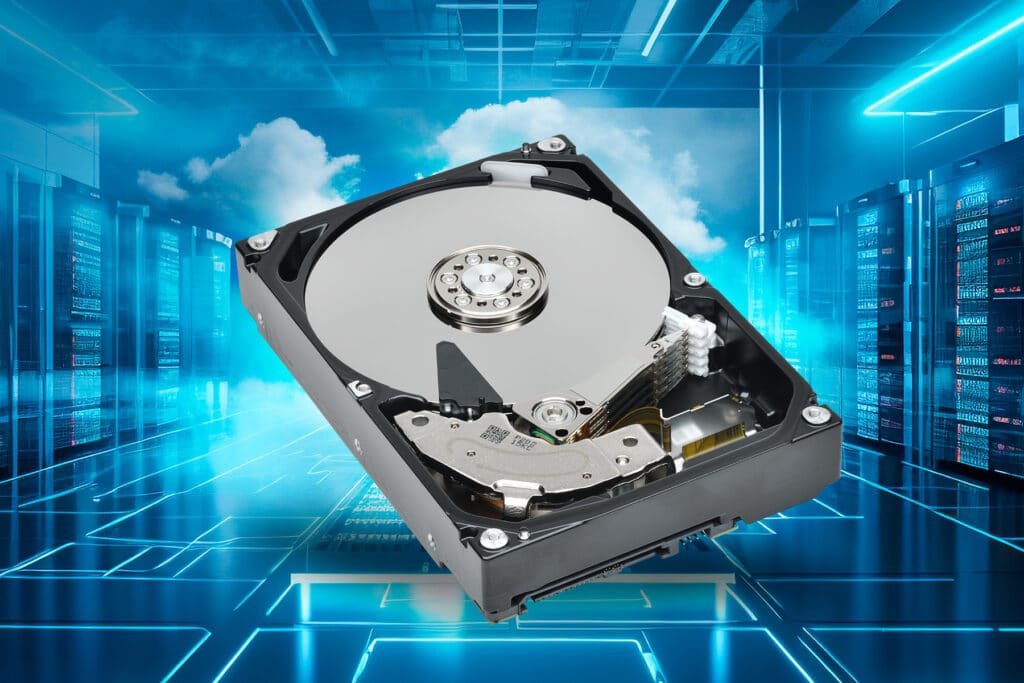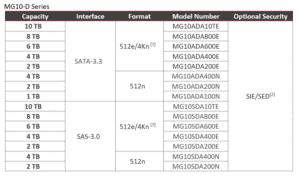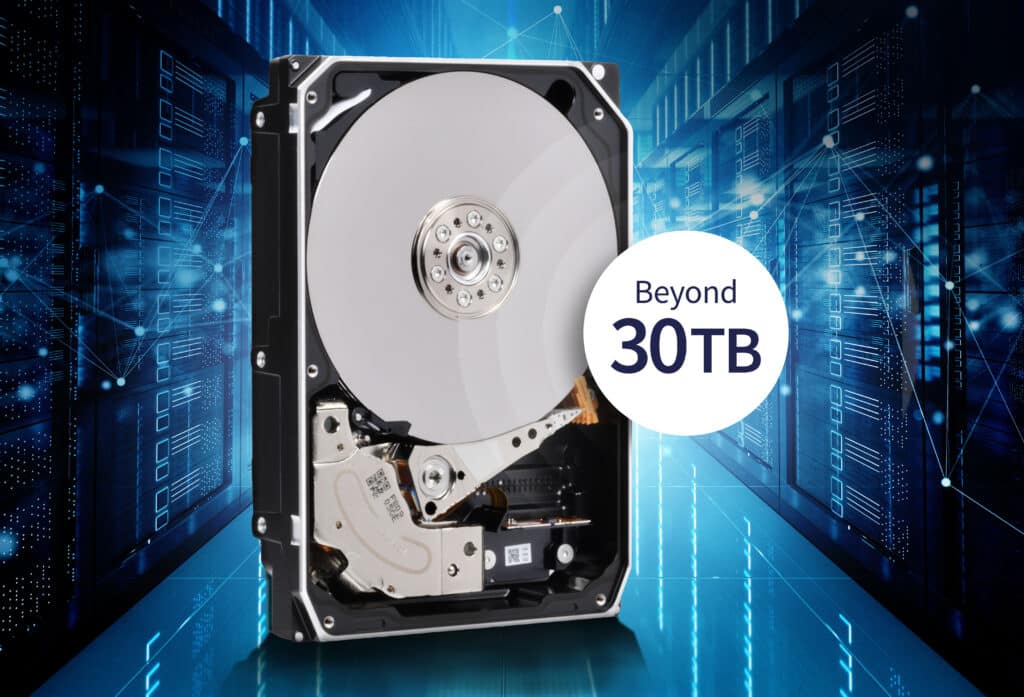24.06.2024
Toshiba Announces MG10-D Series of Enterprise HDDs with Capacities up to 10TB

Düsseldorf, Germany, 25 June 2024 – Toshiba Electronics Europe GmbH (Toshiba) announces the release of its MG10-D Series, a family of air-filled conventional magnetic recording (CMR) HDDs supporting SAS and SATA interfaces and capacities of up to 10TB[1]. Crafted with precision engineering and over 50 years of Toshiba experience, the MG10-D Series delivers improved performance and power efficiency over prior generations. With sanitize instant erase (SIE) and self-encrypting drive (SED) options[2], valuable data is safeguarded by a storage solution known for its robust performance and unwavering dependability.
Built for the increasing application demands of enterprise server and storage solutions, the MG10-D Series delivers a new level of performance. For example, compared with the previous model[3], the new 10TB MG10ADA10TE provides an approximately 13% better maximum sustained transfer speed of 268MiB/s[4] and doubles the cache buffer size to 512MiB[5]. It also reduces power consumption in active idle mode by approximately 21%, to 5.74W. Architected to deliver improved total cost of ownership (TCO), the new MG10-D Series fits seamlessly into a wide variety of business-critical applications, such as email, data analytics, data retention, and surveillance.
“Toshiba’s MG10-D Series delivers exceptional performance to meet the demands of growing business critical applications. The new cutting-edge design of the MG10-D Series is engineered for sustainable enterprise environments and fits seamlessly into existing infrastructure reducing TCO,” said Larry Martinez-Palomo, Vice President, Head of Storage Products Division at Toshiba.
The MG10-D Series is a 5-disk CMR standard 3.5-inch[6], 7200 RPM air-filled platform. Available capacities are 2TB, 4TB, 6TB, 8TB, and 10TB for both SAS and SATA. SATA is also available in a 1TB drive. The series supports 6Gb/s SATA or 12Gb/s SAS interface options in Advanced format 512e and 4Kn[7]. A 512n option is available on the 1TB, 2TB, and 4TB offerings to support legacy systems with native 512 byte block sizes. Designed for 24×7 enterprise reliability, the MG10-D Series has a workload rating of 550TB, an AFR of 0.44% and an MTTF/MTBF[8] of 2M hours.
The MG10-D Series will be available in CQ3.
MG10-D Series

For more information on Toshiba’s full line of HDD storage products, please visit: www.toshiba.semicon-storage.com or www.toshiba-storage.com .
Please download the Press Release here.
[1] Definition of capacity: One terabyte (TB) = one trillion bytes, but storage capacity actually available may vary, depending on operating environment and formatting. Available storage capacity (including examples of various media files) will vary based on file size, formatting, settings, software and operating system and/or pre-installed software applications, or media content. Actual formatted capacity may vary.
[2] The HDDs which have any optional security function may not be available in the countries where the use of such HDDs is prohibited or limited due to export control and local regulations.
[3] Comparison between the SATA interface 512e model “MG10ADA10TE” and the previous generation “MG06ACA10TE.”
[4] Read and write speeds may vary depending on the host device, read and write conditions, and file size.
[5] A mebibyte (MiB) is 220, or 1,048,576 bytes.
[6] “3.5-inch” mean the form factor of HDDs. They do not indicate drive’s physical size.
[7] Default format is 512e. Convertible to 4kn format.
[8] MTTF/MTBF (Mean Time to Failure/Mean Time Between Failure) is not a guarantee or estimate the product life; it is a statistical value related to mean failure rates for a large number of products which may not accurately reflect actual operation. The actual product life of the product may vary.
* Information in this document, including product prices and specifications, content of services and contact information, is current and believed to be accurate as of the date of the announcement, but is subject to change without prior notice.
* Company names, product names, and service names mentioned herein may be trademarks of their respective companies.
###
14.05.2024
Toshiba Successfully Demonstrates Nearline HDDs with Massive Capacity of Over 30 Terabytes

Düsseldorf, Germany, 14 May 2024 – Toshiba Electronics Europe GmbH announces that Toshiba Electronic Devices & Storage Corporation (Toshiba) has successfully achieved storage capacities of over 30TB[1] with two next-generation large capacity magnetic recording technologies for hard disk drives (HDDs): Heat Assisted Magnetic Recording (HAMR) and Microwave Assisted Magnetic Recording (MAMR). The demonstration drives represent a major milestone in the advance towards commercial products based on each of these emerging recording formats.
HAMR boosts writing capabilities by locally heating the disk material with a near-field laser. Toshiba achieved 32TB on 10 disks using Shingled Magnetic Recording (SMR) – a technology that partially overlaps data tracks to increase the areal density and overall storage capacity per disk. Toshiba plans to start shipping test sample HDDs[2] of 28 – 30TB with HAMR technology in 2025.
The other technology is MAMR, which uses microwaves to enhance magnetic recording capabilities. Toshiba was the first [3] to demonstrate its effectiveness and started mass production of first-generation drives in 2021. Toshiba achieved 31TB capacity by stacking 11 disks, using SMR technology, and improving signal processing.
These new achievements were made possible through years of close collaborative work with Resonac Corporation, a HDD media manufacturer, and TDK Corporation, a HDD head manufacturer. Toshiba and its working partners are committed to continue developing both HAMR and MAMR technologies in order to provide higher capacity HDDs to meet the growing storage demand of the cloud and datacenters.
As Larry Martinez-Palomo, Vice President, Head of Storage Products Division at Toshiba, explains: “Toshiba is concurrently advancing the development of future generation high-capacity HDDs using both HAMR and MAMR technologies. Mass production of hard disk drives incorporating HAMR will commence after the validation phase is completed. In the interim, Toshiba will continue to satisfy the demand for high-capacity, high-reliability storage devices with hard disk drives employing the field-proven MAMR technology.”
At ISC High Performance 2024, May 12th to 16th in Hamburg, Germany, Toshiba and its partners will discuss with experts, how its hard disk drive technologies and enterprise portfolio are streamlined to meet the needs of large and fast online backend storage. On the stand (G02), there will be a live demo showing the astonishing performance of Toshiba’s HDD MG Series. For more details, please visit the Toshiba website at: https://toshiba.semicon-storage.com/eu/company/exhibition/articles/storage_ISC_2024.html
For more information on Toshiba’s full line of HDD storage products please visit www.toshiba.semicon-storage.com or www.toshiba-storage.com .
[1] Definition of capacity: One terabyte (TB) = one trillion bytes, but storage capacity actually available may vary, depending on operating environment and formatting. Available storage capacity (including examples of various media files) will vary based on file size, formatting, settings, software and operating system and/or pre-installed software applications, or media content. Actual formatted capacity may vary.
[2] The test sample capacity aims for 28 to 30TB with Conventional Magnetic Recording (CMR) format.
[3] Toshiba research, as of December 24, 2021
* Information in this document, including product prices and specifications, content of services and contact information, is current and believed to be accurate as of the date of the announcement, but is subject to change without prior notice.
* Company names, product names, and service names mentioned herein may be trademarks of their respective companies.
